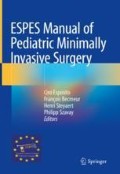Abstract
Little controversy still exists to establish the most appropriate treatment of hypertrophic pyloric stenosis (HPS) in neonates and infants. The nonoperative treatment with oral or intravenous atropine has low acceptance due to the overall success rate of 75–79%, the long-term therapy, and the collateral effects [1, 2]. Surgical treatment described in 1912 by Dr. Conrad Ramstedt remains the suitable standard management option due to the higher success rate (~100%), minimal complications, and shorter hospital stay [1, 3]. In recent years, pediatric laparoscopy and other minimal invasive techniques have found a place in the surgical therapy for HPS offering excellent results but creating some controversy about the benefits when comparing to the open approach [4–6].
Access this chapter
Tax calculation will be finalised at checkout
Purchases are for personal use only
References
Aspelund G, Langer JC. Current management of hypertrophic pyloric stenosis. Semin Pediatr Surg. 2007;16(1):27–33.
Shaw A. Ramstedt and the centennial of pyloromyotomy. J Pediatr Surg. 2012;47(7):1433–5.
Sola JE, Neville HL. Laparoscopic vs. open pyloromyotomy: a systemic review and meta-analysis. J Pediatr Surg. 2009;44(8):1631–7.
Oomen MWN, Hoekstra LT, Ubbink DT, et al. Open versus laparoscopic pyloromyotomy for hypertrophic pyloric stenosis: a systematic review and meta-analysis focusing on major complications. Surg Endosc. 2012;26(8):2104–10.
Boybeyi O, Karnak I, Ekinci S, et al. Late-onset hypertrophic pyloric stenosis: definition of diagnostic criteria and algorithm for the management. J Pediatr Surg. 2010;45(9):1777–83.
Juang D, Adibe OO, Laituri CA, et al. Distribution of feeding styles after pyloromyotomy among pediatric surgical training programs in North America. Eu J Pediatr Surg. 2012;22(5):409–11.
Oomen MWN, Hoekstra LT, Baky R. Learning curves for pediatric laparoscopy: how many operations are enough? The Amsterdam experience with laparoscopic pyloromyotomy. Surg Endosc. 2010;24:1829–33.
Haricharan RN, Aprahamian CJ, Celik A, et al. Laparoscopic pyloromyotomy: effect of resident training on complications. J Pediatr Surg. 2008;43(1):97–101.
Taylor SP, Hoffman GM. Gas embolus and cardiac arrest during laparoscopic pyloromyotomy in an infant. Can J Anaesth. 2010;57(8):774–8.
Fischler M. Carbon dioxide embolism in a 3-week-old neonate during laparoscopic pyloromyotomy: a case report. J Pediatr Surg. 2009;44(9):1864.
Kudsi OY, Jones SA, Brenn BR. Carbon dioxide embolism in a 3-week-old neonate during laparoscopic pyloromyotomy: a case report. J Pediatr Surg. 2009;44(4):842–5.
Turial S, Enders J, Schier F, et al. Comparison of a novel technique of the microlaparoscopic pyloromyotomy to circumbilical and Weber-Ramstedt approaches. J Gastrointest Surg. 2011;15(7):1136–42.
Muensterer OJ, Adibe OO, Harmon CM, et al. Single-incision laparoscopic pyloromyotomy: initial experience. Surg Endosc. 2010;24(7):1589–93.
Zhang YX, Nie YQ, Xiao X, et al. Treatment of congenital hypertrophic pyloric stenosis with endoscopic pyloromyotomy. Zhonghua Er Ke Za Zhi. 2008;46(4):247–51.
Walker K, Halliday R, Holland AJ, et al. Early developmental outcome of infants with infantile hypertrophic pyloric stenosis. J Pediatr Surg. 2010;45(12):2369–72.
Author information
Authors and Affiliations
Corresponding author
Editor information
Editors and Affiliations
Rights and permissions
Copyright information
© 2019 Springer Nature Switzerland AG
About this chapter
Cite this chapter
Montupet, P., Esposito, C., Mendoza-Sagaon, M. (2019). Laparoscopic Pyloromyotomy. In: Esposito, C., Becmeur, F., Steyaert, H., Szavay, P. (eds) ESPES Manual of Pediatric Minimally Invasive Surgery . Springer, Cham. https://doi.org/10.1007/978-3-030-00964-9_26
Download citation
DOI: https://doi.org/10.1007/978-3-030-00964-9_26
Published:
Publisher Name: Springer, Cham
Print ISBN: 978-3-030-00963-2
Online ISBN: 978-3-030-00964-9
eBook Packages: MedicineMedicine (R0)

